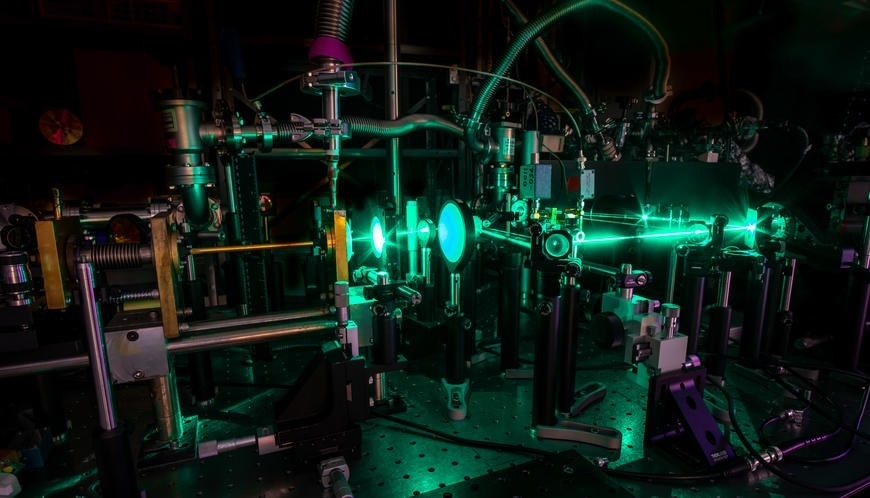Nov 15 2019
The terahertz frequency range shows promise in precise long-range sensing for radio astronomy, ultra high-resolution imaging, and high-bandwidth communications, to name a few. This frequency range falls at the center of the electromagnetic spectrum between infrared light and microwaves.
 Picture of the experimental setup showing the different components of the system. Image Credit: Arman Amirzhan, Harvard SEAS.
Picture of the experimental setup showing the different components of the system. Image Credit: Arman Amirzhan, Harvard SEAS.
However, this part of the electromagnetic spectrum has continued to be elusive for a majority of applications. The reason is existing sources of terahertz frequencies are inefficient, large, have reduced tuning range, or need to work at low temperatures.
Now, in association with MIT and the U.S. Army, scientists from the Harvard John A. Paulson School of Engineering and Applied Sciences (SEAS) have created a room-temperature terahertz laser that is compact and widely tunable. The study has been published in the Science journal.
This laser outperforms any existing laser source in this spectral region and opens it up, for the first time, to a broad range of applications in science and technology,”
Federico Capasso, Robert L. Wallace Professor of Applied Physics and Vinton Hayes Senior Research Fellow, Electrical Engineering, Harvard SEAS
Capasso is the co-senior author of the study.
“There are many needs for a source like this laser, things like short-range, high bandwidth wireless communications, very high-resolution radar, and spectroscopy,” stated Henry Everitt, co-senior author of the study and Senior Technologist with the U.S. Army CCDC Aviation & Missile Center. He is also an Adjunct Professor of Physics at Duke University.
A majority of optical or electronic terahertz sources utilize bulky, complex, and inefficient systems to create the elusive frequencies that have a reduced tuning range. However, Capasso, Everitt, and their research team adopted a different method.
To understand what exactly the researchers did, it would be best to go through the fundamental physics of how a laser operates.
In the field of quantum physics, excited molecules or atoms are located at different energy levels—one can envisage these as a building’s floors. In a standard gas laser, a huge number of molecules are confined between a pair of mirrors and converted to an excited energy level, or similar to a higher floor in the building. Upon reaching that floor, the molecules decay, go down one energy level, and produce a photon.
Such photons activate the decay of more numbers of molecules as they bounce to and fro, resulting in the amplification of light. To alter the frequency of the produced photons, the energy level of the excited molecules has to be changed.
So, how to alter this energy level? Light provides an option to do this. In a process referred to as optical pumping, it is light that elevates the molecules from a lower energy level to a higher level—just like a quantum elevator.
Terahertz molecular lasers developed in the past employed optical pumps; however, they had limited tunability of just a few frequencies. This means the elevator just reached a few numbers of floors.
The innovation of this study is that Capasso, Everitt, and their research team employed a widely tunable, quantum cascade laser as their optical pump. Jointly developed by Capasso and his team at Bell Labs in the 1990s, these portable and robust lasers can efficiently create highly tunable light. This implies that the quantum elevator can halt at each floor in the building.
The concept to improve the operation of the novel laser was devised by Steven Johnson, Professor of Applied Mathematics and Physics at MIT, along with Fan Wang and Everitt. The team integrated the quantum cascade laser pump with a nitrous oxide—also known as laughing gas—laser.
By optimizing the laser cavity and lenses, we were able to produce frequencies spanning nearly 1 THz.
Arman Amirzhan, Study Co-Author and Graduate Student, Harvard SEAS
Amirzhan is part of Capasso’s group.
“Molecular THz lasers pumped by a quantum cascade laser offer high power and wide tuning range in a surprisingly compact and robust design,” stated Nobel laureate Theodor Hänsch of the Max Planck Institute for Quantum Optics in Munich, who was not part of the study. “Such sources will unlock new applications from sensing to fundamental spectroscopy.”
“What’s exciting is that concept is universal,” said Paul Chevalier, first author of the study and a postdoctoral fellow at SEAS. “Using this framework, you could make a terahertz source with a gas laser of almost any molecule and the applications are huge.”
This result is one of a kind. People knew how to make a terahertz laser before but couldn’t make it broadband. It wasn’t until we began this collaboration, after a serendipitous encounter with Henry at a conference, that we were able to make the connection that you could use a widely tunable pump like the quantum cascade laser.
Federico Capasso, Robert L. Wallace Professor of Applied Physics and Vinton Hayes Senior Research Fellow, Electrical Engineering, Harvard SEAS
The new laser can be utilized in all applications, such as drug detection, improved breast and skin cancer imaging, ultrahigh-capacity optical wireless links, and airport security.
“I’m particularly excited about the possibility of using this laser to help map the interstellar medium,” added Everitt. “Molecules have unique spectral fingerprints in the terahertz region, and astronomers have already begun using these fingerprints to measure the composition and temperature of these primordial clouds of gas and dust.”
Everitt continued, “A better ground-based source of terahertz radiation like our laser will make these measurements even more sensitive and precise.”
The Harvard Office of Technology Development has protected the intellectual property associated with this project and is looking for commercialization opportunities.
The study was co-authored by Wang, Marco Piccardo (Harvard), and Johnson, and was partly supported by the U.S. Army Research Office and the National Science Foundation.